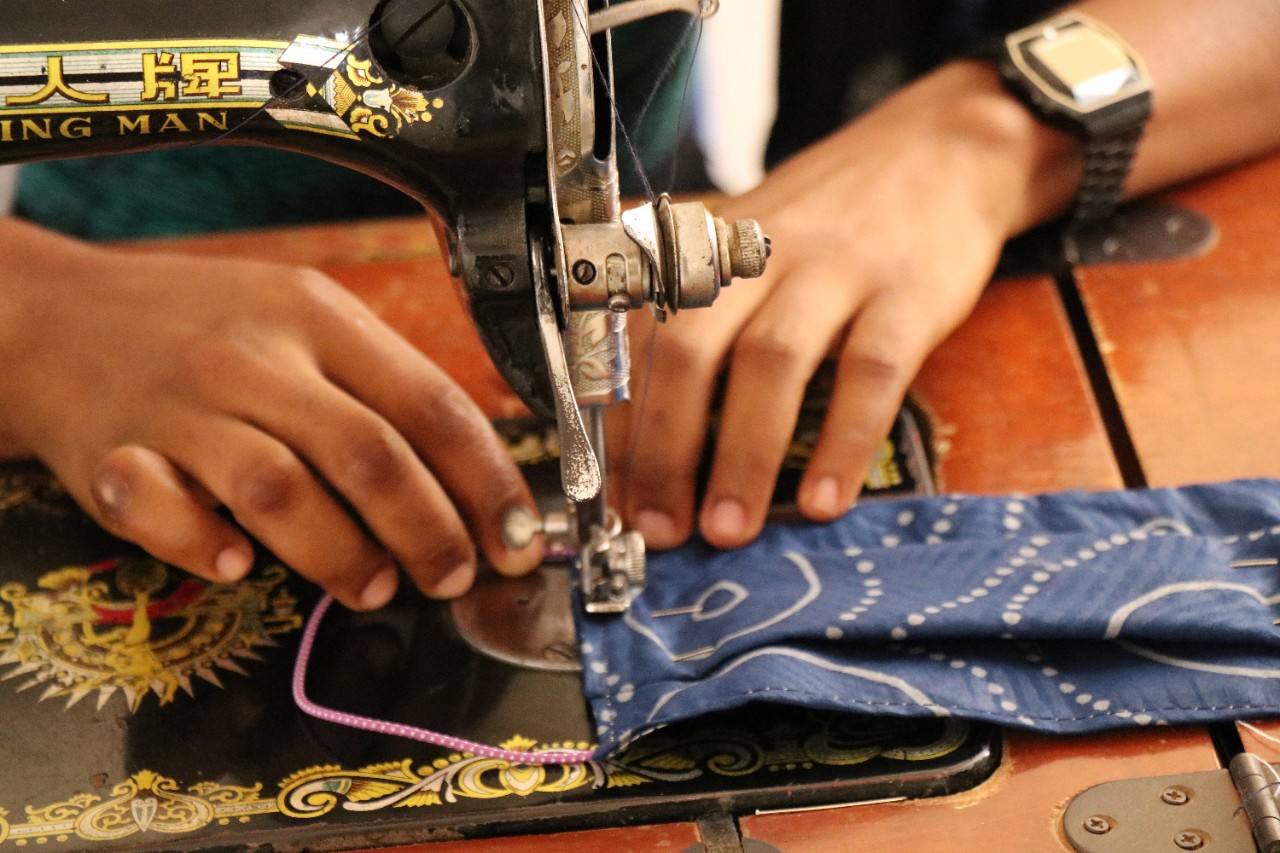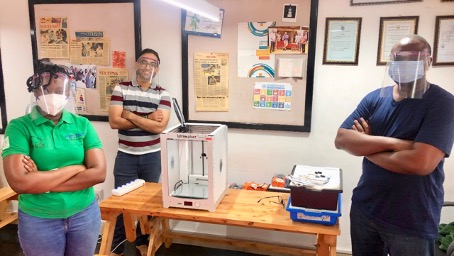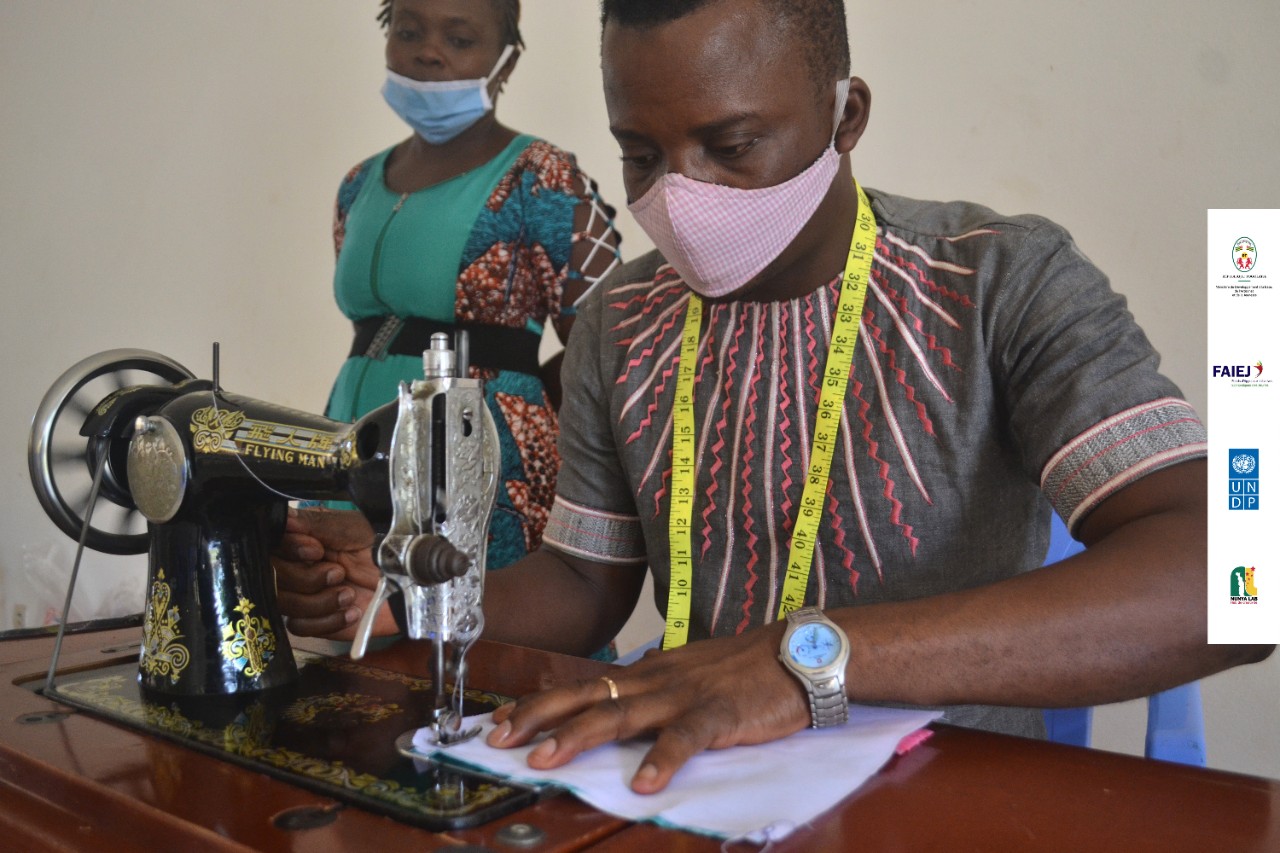Personal.
Protective.
Equipment.
How could we have known pre-pandemic that we would become so familiar with the acronym, PPE? How could we have imagined that we would regularly place a piece of cloth or a piece of plastic over our faces, creating a barrier from others from a virus that took the world by storm?
In March 2020, WHO estimated that 89 million masks, 76 million examination gloves and 1.6 million goggles were needed per month. Demand was far outweighing supply, and healthcare workers were at grave risk.
Quick and large production of PPEs became a critical challenge. Across the world, from Ecuador to Togo, strict lockdown measures were put in place, sometimes overnight. Not only was there not enough PPE for the general population, but even healthcare workers couldn’t be protected and some hospitals in small cities in Africa had no PPE at all. Borders closed, main production factories too and global supply chains were put on hold. The perfect equation for chaos: a roaring demand meeting a gap in supply.
In this suspended moment, what we witnessed was unprecedented. Necessity became the mother of invention. Some governments – like in Viet Nam, New Zealand and South Korea – realized the importance of tapping into the distributed knowledge of innovators and citizen-led initiatives. They didn’t want to rely on a solution from abroad, or wait for an indefinite time for the global supply chain to be fixed, nor did they see themselves as fixers of the market failures. They turned to people to collaborate and solve this shortage issue together.
Since this bottom-up approach to problem-solving is part of the DNA of the 91 UNDP Accelerator Labs, it is not surprising that many of the Labs in our network pivoted quickly when the pandemic hit in 2020 and became conveners in their local innovation ecosystems to curb the shortage of PPE.
From Colombia to Tanzania and Ecuador, the Labs tapped into the knowledge and production capacity of makers communities (think 3D printing), academia, and grassroots actors, like local seamstresses or dressmakers. They connected these bottom-up innovators to governments or industry partners to invent and accelerate the local production of much needed masks. Reduced waiting time, less reliance on the global mask diplomacy. The Labs were shortcutting the global supply chain by co-designing solutions with local inputs that were vital to the pandemic response.
Convening local innovators to create new, bottom-up and fast supply chains
Face mask detection system (left) and automated temperature detector and hand-sanitizer dispenser tested at local schools (right) are two open-source innovations designed at the Makerthon in South Africa, in September 2020.
In South Africa, the UNDP Accelerator Lab supported the Makerthon, a joint innovation challenge between UNDP, Hackster.io and Wits Tshimologong Digital Innovation Precinct to help surface innovative methods of producing PPE and other innovations in response to COVID-19. In September 2020, innovators, makers and developers were invited to develop open-source, low-tech and inexpensive hardware solutions. For example, one team created the “Authorized Entry Using Face Mask Detection System,” which uses facial recognition technology to detect whether a person is wearing a face mask in public spaces. If a person is not wearing a mask, an alarm rings denying access to the venue. A contactless temperature detector equipped with a hand-sanitizer dispenser was also developed and tested at local schools, where it proved very popular with children. Most of the innovations have since been tested and are currently seeking additional resources for further development. The 3D printers and laser cutters were donated to the Tshimologong Innovation Precinct where the equipment continues to be used by local innovators.
Similarly, the UNDP Colombia Accelerator Lab tapped into local expertise to prototype robust, closed face shields that could be produced and distributed quickly. They created the Life Helmets Challenge and invited the government, the maker community, academia and industry partners to collaborate and funnel ideas to the platform in a matter of days.
Over 400 proposals were received, with winning submissions from students to DIY makers, one doctor and one taxi driver. The Life Helmets platform is now a hub for sharing open-source designs of PPE and a marketplace for the winning solutions. Members of the public and companies use the platform to buy and sell face shields. By now, UNDP Colombia has purchased and distributed more than 47,000 face shields across the country, including in remote locations where communities have struggled to access PPE.
And this way of working is spreading. Since its creation, the digital production techniques that emerged from Life Helmets, such as 3D printing and laser cutting designs, have been used by UNDP Peru, the Pan American Health Organization (PAHO/WHO), the Municipality of Lima, PerúMakers and the FabLabs Peru network. This conglomerate of actors has since designed a new generation of personal protection equipment – 1,100 Cascos de Vida to be precise – made of biodegradable and recyclable plastic and built upon UNDP Colombia’s Accelerator Labs research. A “Life Helmet” movement has begun!
The maker movement goes frugal
Dar Es Salaam maker community used low-cost 3D printing to design, fabricate and distribute PPEs.
As the crisis unfolded, 3D masks emerged as another creative avenue for the local production of PPE. A 3D printer and a digital file, that’s “all” you need. The maker community started to organize itself, share open-source files and provide much needed face shields.
In Tanzania, the UNDP Accelerator Lab turned to the Dar Es Salaam maker communituy to use low-cost 3D printing to design, fabricate and distribute PPEs and other low-cost equipment such as intubation boxes, handwashing stations and ventilators to help protect front line health workers across the country, particularly those serving in quarantine centers for COVID-19 patients. As conveners of the community, the Lab team was then able to bring in Dar es Salaam Institute of Technology (DIT) design studio — a government Lab housed at the Dar Es Salaam Institute of Technology – and DIT’s wide range of partners: the Science Technology and Innovation Center Lab (STIC), Uhuru labs, Mbeya University of Science and Technology, Bits&bytes and Robotech from the private sector. This unusual mix of government institutions, private hubs and DIY makers convened by the Tanzanian Lab was able to produce 2,000 face shields at a fraction of the cost of what an imported one would cost.A locally produced PPE costs US$2, whereas imported ones sell for up to US$11 a piece: a testament to the power of frugal innovation in a crisis.
DIY artisans and quality standards
From theory to practice, craftsmen take action. Photo: Nunyalab
In Togo, the main challenge was to meet the need for affordable protective masks that comply with minimum standards of protection set by international organizations of reference such as the Grenoble University Hospital and the French Standardization Association (AFNOR). Firstly, UNDP Togo, powered by its Accelerator Lab, spearheaded talks with the University of Lomé on the implementation of public quality control services, even acquiring standardization norms documents for the university. This led the institution to set up a fully functional Quality Assurance Committee specialized in certifying the quality of PPEs. Secondly, the Lab saw an opportunity to harness the talents of local seamstresses and tailors, idle since the outbreak of the pandemic, and train them to create alternative fabric-based masks. They brought together a wide range of stakeholders such as the NunyaLab, the Union of Regional Chambers of Trades and the National Health Insurance Institute, to organize and finance these sessions. By the end of this initiative, over 800 artisans had made more than 1 million reusable masks sold in pairs for 350 CFA francs (US$0.50), 65 per cent cheaper than masks available in the early days of the COVID-19 outbreak. Lastly, the lab team shared the knowledge acquired by local seamstresses and tailors publicly by creating a “How to make your own face mask?” tutorial video (in French, broken down in four bite-sized parts) which was shared via WhatsApp and YouTube.
In Ecuador, the UNDP Accelerator Lab also tapped into the skills of local artisans to produce masks fast. They created a “cash for training” program, directed to a network of 27 seamstresses that eventually grew to 56, which consisted in training them in PPE production in exchange of a small payment. It was based on peer-to-peer learning and exchange which was then self-organized and peer-led. Through this program, the seamstresses ran training sessions, exchanged knowledge and shared sewing materials and tools. They received necessary guidance on compliance with biosafety standards. Tapping collective intelligence, the Accelerator Lab mobilized the skills and assets in this community, which proved vital to the pandemic response. It also encouraged economic empowerment, so the seamstresses not only helped address the PPE shortage but found a new source of income and organized themselves into an association which persists. Nearly 800 units of PPE, including masks, overalls, caps and boot protectors, were donated to two hospitals (the Centro de Salud Guamaní in Quito, and the Hospital de IESS de Machala), the laboratory of the National Institute for Public Health Research and the Ministry of Agriculture according to the hospitals’ quality assurance standards.
In Malawi, the UNDP Accelerator Lab partnered with six universities and Engineers Without Borders to develop locally 30,000 face shields and 10,000 fabric face masks according to WHO international health standards in the absence of clear standards provided at the national level. Eight thousand of these masks were donated by the Malawi University of Science and Technology to various district hospitals in the Southern Region and two central hospitals. In addition to acting as a convener between these partners to provide much-needed masks, the Lab also involved national regulatory bodies such as the Malawi Bureau of Standards and Malawi’s Pharmacy and Medicines Regulatory Authority to assess and certify the production of 60+ foot-activated handwashing stations and 17,500 liters of disinfectants for health facilities, schools, prisons, and 44,000 hand sanitizers for health workers.
In Malawi, for PPE and other items with health standards, such as hand sanitizers, the Lab worked with national standards and regulatory bodies to certify the products before donation.
Sustaining innovation for the next crisis
Whether or not we can see the light at the end of the tunnel for the pandemic, we can look ahead to see what we’ve learned from this period in time – what innovations have lasting impacts, what new discoveries were made and how people will continue to improve their lives and livelihoods as economies slowly recover.
Now and not someday in the future, we need to figure out how to sustain innovation and foster distributed problem solving so that what we’ve learned has value, to make us better prepared for the next crisis. We have seen that there is a new kind of partnership emerging, where the best course forward is a collaborative relationship between citizens, health authorities and a wide and unusual range of local problem solvers.
We’ve learned how to pivot existing networks fast to respond to current and future crises, and how to bring the tools needed to ensure quality. Just like in Malawi, where the Lab is bringing together international experts such as the Department of Chemical Engineering and Biotechnology at University of Cambridge and Dr Jenny Molloy, a Shuttleworth Foundation Research Fellow, with local scientists through the UN Technology Access Partnership to produce molecular testing reagents which have potential to be used in COVID testing as well as other viral diseases, therefore, building capability for the country to respond to future pandemics.
We can and should continue to nurture fruitful relationships and symbiotic collaborations between local DIY innovators themselves, other local organizations and governments, and in this way, tap into the value of distributed intelligence which is going to strengthen our communities for future crises and the problems we currently face.
With contribution from:
- Yem Ahiatsi, Head of Solutions Mapping, UNDP Togo
- Paulina Jimenez, Head of Solutions Mapping, UNDP Ecuador
- Peter Nyanda, Head of Exploration, UNDP Tanzania
- Klariska Moodley, Head of Experimentation, UNDP South Africa
- Soyapi Mumba, Head of Experimentation, UNDP Malawi
- Sofia Paredes Chaux, Head of Exploration, UNDP Colombia

 Locations
Locations









